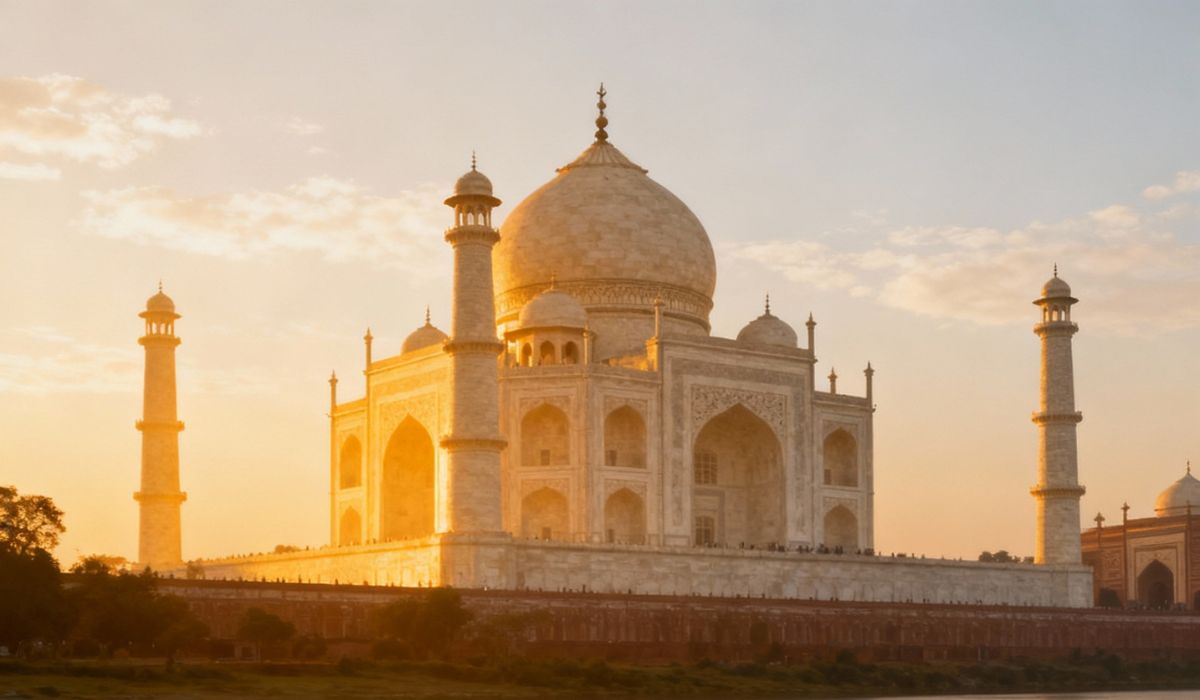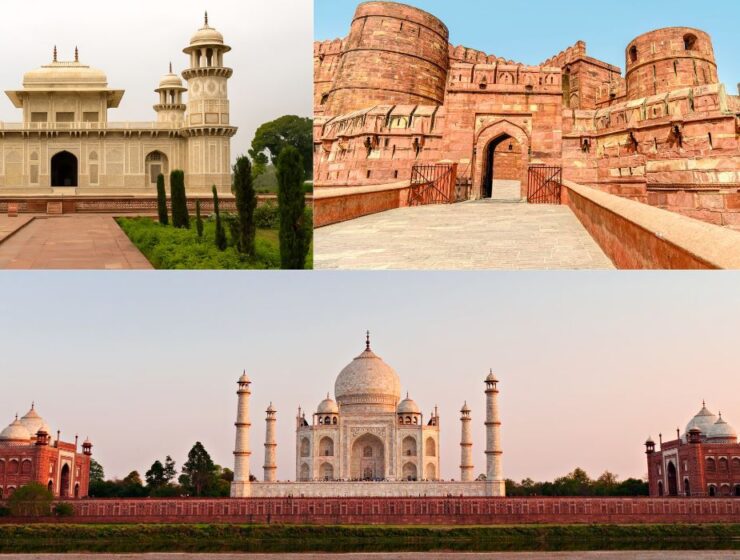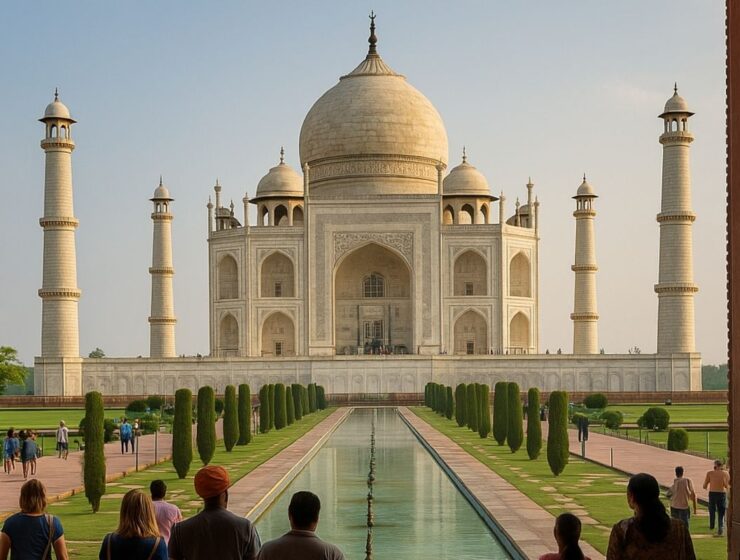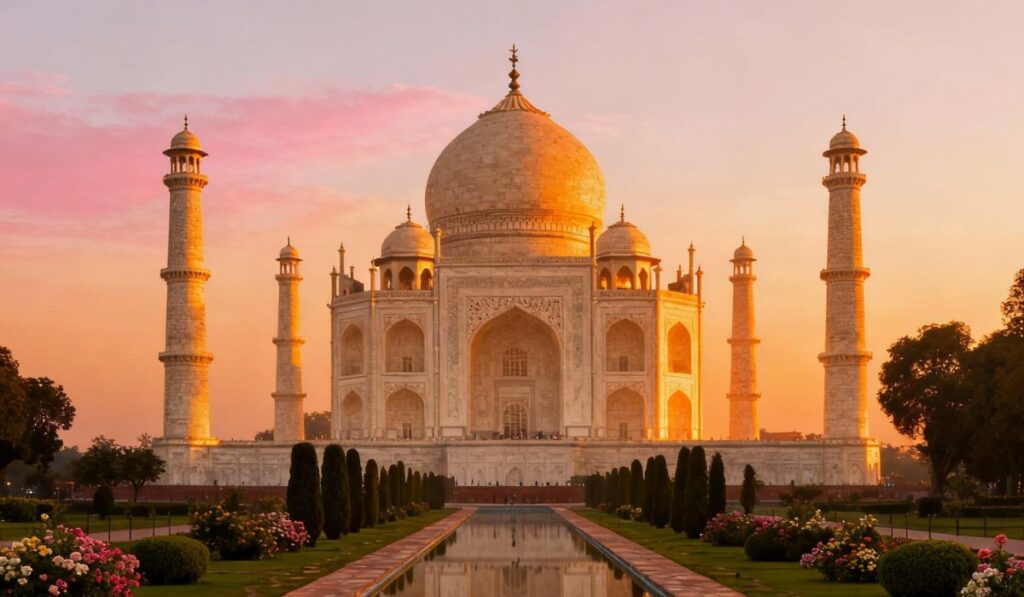
Visiting the Taj Mahal is not just about seeing a monument – it’s about experiencing a story of love, artistry, and timeless beauty. Whether it’s witnessing the marble glow at sunrise, photographing the iconic reflection in the Yamuna, or stumbling upon hidden corners like the Taj Mahal mosque, each visitor uncovers a unique memory. In this travel guide, I’ll share the best Taj Mahal experiences, including epic photo spots, the night view under the full moon, and little-known gems, so you can make your visit unforgettable.
Best Time to Visit Taj Mahal for Magical Views
The magic of the Taj Mahal isn’t the same at all hours of the day. The changing light transforms its marble into shades of pink, golden, or silvery white. Choosing the best time to visit Taj Mahal ensures you witness its full charm.
Here’s a quick guide to help you decide:
| Time of Day | Experience | Photography Advantage | Crowd Level | Recommended Season |
|---|---|---|---|---|
| Sunrise | Gentle golden glow, peaceful atmosphere | Soft light, fewer shadows | Low crowd | October – March |
| Midday | Bright and clear views | Best for close-up marble details | High crowd | November – February |
| Sunset | Warm orange-pink hues over marble | Dramatic silhouette shots | Medium | October – March |
| Full Moon Night | Silver glow, magical ambiance | Rare night photography | Very limited (ticket-based) | Year-round (consult lunar calendar) |
Sunrise at the Taj Mahal
Stepping into the complex at dawn feels like stepping into a painting. With soft golden rays touching the white marble, the Taj Mahal seems to float in the first light of the day. The crowds are lesser at sunrise, giving you a quieter, more intimate experience. Photographers often say morning is the best time to capture the monument without harsh shadows. Personally, my sunrise visit left me speechless – the peaceful Yamuna reflected the monument perfectly, and birds circled gently above the dome as if nature itself was in awe.
Sunset at the Taj Mahal
If sunrise is calming, sunset at the Taj Mahal is pure drama. The sky paints the mausoleum in warm hues of orange and amber, creating a surreal view. Standing by the fountains and seeing its silhouette as the sun dips behind the horizon made me realize why it’s considered one of the world’s most romantic settings. For those who want fewer tourists but equally breathtaking views, sunset is an excellent option.
Taj Mahal Night View During Full Moon
Few experiences rival the Taj Mahal night view under a full moon. The marble shines like silver, casting an ethereal glow reflecting the eternal love story of Shah Jahan and Mumtaz. This rare experience is only permitted five nights a month – on the full moon night, two nights before, and two nights after. Standing in the quiet, gazing at the shimmering structure under starlight, is something words barely capture. It feels like the Taj Mahal was designed to be appreciated by moonlight.
The Great Gate of the Taj Mahal – A Grand Welcome
Before you even glimpse the main structure, you’ll pass through the Great Gate of the Taj Mahal (Darwaza-i-Rauza). This monumental red sandstone gateway sets the tone for what’s ahead. Intricate calligraphy carved onto white marble panels quotes verses from the Quran, symbolizing an eternal welcome. Walking through this gate always gives me goosebumps – the framing of the Taj through its central arch feels like walking into a masterpiece. Many travelers overlook spending time here, but it’s worth pausing to appreciate its symmetry and grandeur.
Taj Mahal Photo Shoot – Capturing Timeless Memories
Whether you’re a professional photographer or a traveler with a smartphone, a Taj Mahal photo shoot is a must-do experience. The monument is one of the most photographed places in the world, yet each picture feels uniquely personal.
Iconic Photography Spots Inside the Complex
- The reflecting pool in the Charbagh garden gives the classic postcard shot most tourists dream of – the Taj Mahal reflected on a still surface.
- Close-up marble inlay work on the plinth offers artistic, detailed photography.
- The side angle from near the mosque or guest house captures the monument’s symmetry against the sky backdrop.
Each angle has a story to tell, but my favorite shot remains the one through the Great Gate as the first rays of the sun hit the dome.
Here’s a quick table of best Taj Mahal photo spots to help you capture timeless memories:
| Location | Why It’s Special | Best Time for Photos | Style of Shot |
|---|---|---|---|
| Great Gate | Framed view of Taj dome through arch | Sunrise | Symmetry & perspective |
| Reflecting Pool (Charbagh garden) | Classic postcard reflection | Early morning | Wide angle iconic shots |
| Taj Mahal Mosque Side | Contrast of white marble and red sandstone | Late afternoon | Architectural detail |
| Mehtab Bagh (Yamuna Riverside) | Serene reflections across the river | Sunset & Full moon | Landscape & romantic shots |
| Diana’s Bench (central garden) | Famous iconic spot for portraits | Morning | Travel portraits / Instagram |
| Archways inside mosque & guest house | Creative silhouette framing | Afternoon & dusk | Artistic photography |
Taj Mahal Photo Shoot from Mehtab Bagh & Yamuna Riverside
For those seeking unique perspectives, crossing the Yamuna River to Mehtab Bagh (Moonlight Garden) is worth it. From here, the Taj Mahal appears serene and less crowded, with the river offering beautiful reflection shots. A peaceful walk along the riverside also provides opportunities for silhouette photography, especially at sunset and full moon nights. Many professional photographers recommend this hidden gem for wedding shoots or cinematic captures.
Taj Mahal Mosque – An Overlooked Gem of Mughal Art
On the western side of the Taj Mahal stands a beautiful red sandstone mosque – often overshadowed by the monument itself but equally important. The Taj Mahal mosque is a functioning place of prayer and a striking example of Mughal architecture with its domes, calligraphy, and inlaid stonework. Stepping into this quiet corner of the complex gave me a sense of calm after the crowded garden area. It’s also an excellent spot to watch how the white marble contrasts against the deep red of the mosque at different times of day.
Taj Mahal Wallpapers & Instagram Spots
For today’s travelers, the Taj Mahal doubles as a treasure trove of social media moments. Iconic Taj Mahal wallpaper shots include the marble glowing pink at dawn, the intricate lattice windows casting shadows, and symmetrical arches framing the dome. Instagram-worthy locations inside the complex are:
- The central bench in the garden (famously where Princess Diana was photographed).
- Side archways of the mosque and guest house for creative silhouette shots.
- Aerial-inspired angles from the entrance plaza for storytelling reels.
Each corner provides a lasting memory, making the Taj one of the world’s most photographed monuments.
Taj Mahal Palace Review – Luxury Stay Experience in Agra
A visit to the Taj Mahal becomes even more memorable if you stay at a luxury hotel nearby. The Taj Mahal Palace Review often finds that the Taj Hotel in Agra offers guests not only comfort but also heritage-inspired interiors, Mughal-style gardens, and dining with a backdrop of the monument itself. My stay felt like an extension of the Taj experience – sipping tea while watching the dome glow in twilight was indescribable. For travelers seeking premium comfort, it’s a perfect blend of hospitality and history.
FAQs on Best Time to Visit, Night View & Photography
Q: What is the best time to visit the Taj Mahal?
The best time is during sunrise or sunset when the light enhances the marble’s glow. Winter months (October–March) offer clearer skies and pleasant temperatures.
Q: How to see the Taj Mahal night view?
You need to book special night tickets, available five nights a month around the full moon. Booking should be done in advance as slots are limited.
Q: Where can I capture the best Taj Mahal photo shoot?
Inside the gardens for the classic reflection shot, the archways of the Great Gate, and across the Yamuna river at Mehtab Bagh provide the most iconic views.
Q: Is the Taj Mahal mosque open to visitors?
Yes, it’s open except on Fridays when prayers are held. Tourists are welcome to admire and photograph its intricate details.
Final Thoughts – Why the Taj Mahal Experience Stays with You Forever
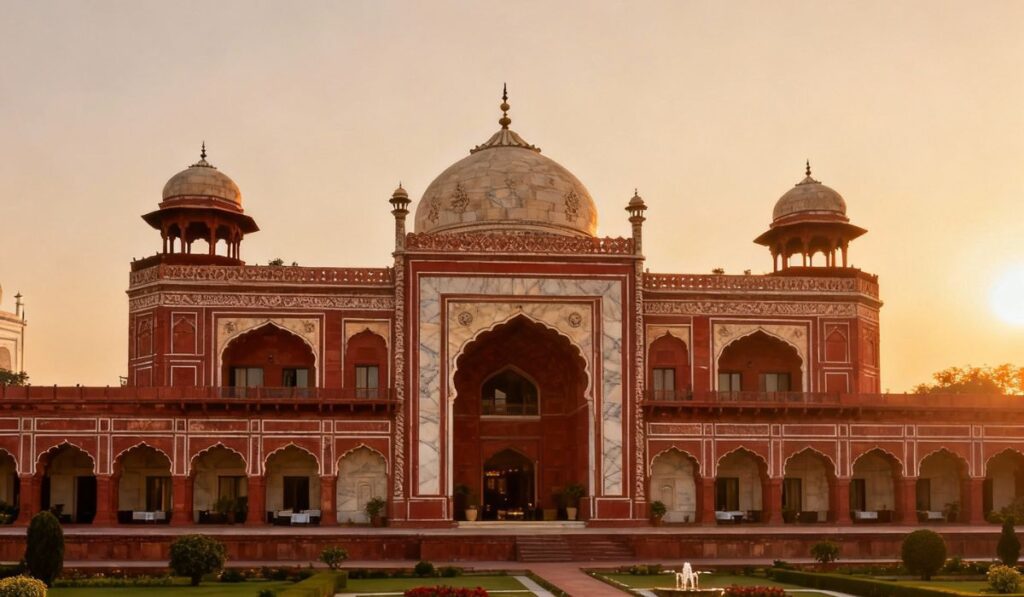
The Taj Mahal isn’t simply a monument you visit and leave – it’s an experience that etches itself into your memory. From the Great Gate of the Taj Mahal that welcomes you, to an early-morning glow at sunrise, and the surreal Taj Mahal night view during a full moon, each moment feels timeless. Exploring hidden corners like the mosque or capturing perfect photo angles makes you realize why people from all over the world keep returning.
It is not just a world wonder – it’s an emotional journey through history, love, and beauty. And like me, you’ll find yourself replaying your favorite Taj Mahal moments long after you’ve left Agra.
If you’re planning your Taj Mahal trip and want curated experiences, check out Emperor Holidays:

